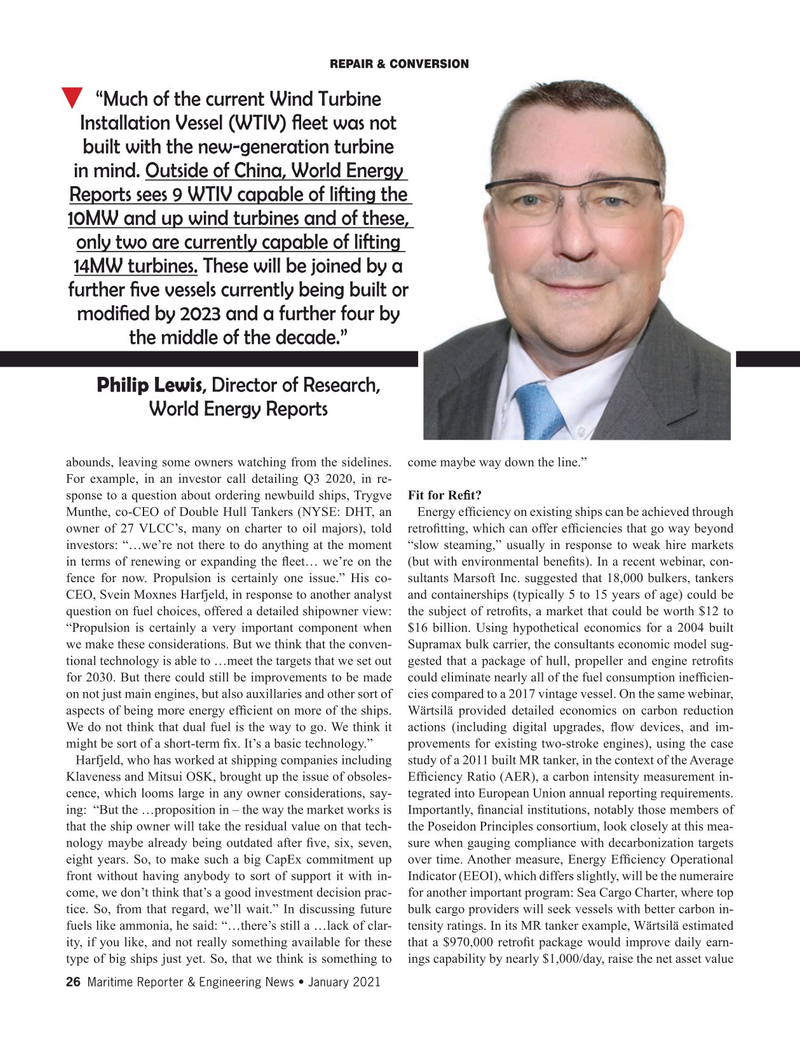
Page 26: of Maritime Reporter Magazine (January 2021)
The Ship Repair & Conversion Edition
Read this page in Pdf, Flash or Html5 edition of January 2021 Maritime Reporter Magazine
REPAIR & CONVERSION “Much of the current Wind Turbine
Installation Vessel (WTIV) ? eet was not built with the new-generation turbine in mind. Outside of China, World Energy
Reports sees 9 WTIV capable of lifting the 10MW and up wind turbines and of these, only two are currently capable of lifting 14MW turbines. These will be joined by a further ? ve vessels currently being built or modi? ed by 2023 and a further four by the middle of the decade.”
Philip Lewis, Director of Research,
World Energy Reports abounds, leaving some owners watching from the sidelines. come maybe way down the line.”
For example, in an investor call detailing Q3 2020, in re- sponse to a question about ordering newbuild ships, Trygve Fit for Re? t?
Munthe, co-CEO of Double Hull Tankers (NYSE: DHT, an Energy ef? ciency on existing ships can be achieved through owner of 27 VLCC’s, many on charter to oil majors), told retro? tting, which can offer ef? ciencies that go way beyond investors: “…we’re not there to do anything at the moment “slow steaming,” usually in response to weak hire markets in terms of renewing or expanding the ? eet… we’re on the (but with environmental bene? ts). In a recent webinar, con- fence for now. Propulsion is certainly one issue.” His co- sultants Marsoft Inc. suggested that 18,000 bulkers, tankers
CEO, Svein Moxnes Harfjeld, in response to another analyst and containerships (typically 5 to 15 years of age) could be question on fuel choices, offered a detailed shipowner view: the subject of retro? ts, a market that could be worth $12 to “Propulsion is certainly a very important component when $16 billion. Using hypothetical economics for a 2004 built we make these considerations. But we think that the conven- Supramax bulk carrier, the consultants economic model sug- tional technology is able to …meet the targets that we set out gested that a package of hull, propeller and engine retro? ts for 2030. But there could still be improvements to be made could eliminate nearly all of the fuel consumption inef? cien- on not just main engines, but also auxillaries and other sort of cies compared to a 2017 vintage vessel. On the same webinar, aspects of being more energy ef? cient on more of the ships. Wärtsilä provided detailed economics on carbon reduction
We do not think that dual fuel is the way to go. We think it actions (including digital upgrades, ? ow devices, and im- might be sort of a short-term ? x. It’s a basic technology.” provements for existing two-stroke engines), using the case
Harfjeld, who has worked at shipping companies including study of a 2011 built MR tanker, in the context of the Average
Klaveness and Mitsui OSK, brought up the issue of obsoles- Ef? ciency Ratio (AER), a carbon intensity measurement in- cence, which looms large in any owner considerations, say- tegrated into European Union annual reporting requirements. ing: “But the …proposition in – the way the market works is Importantly, ? nancial institutions, notably those members of that the ship owner will take the residual value on that tech- the Poseidon Principles consortium, look closely at this mea- nology maybe already being outdated after ? ve, six, seven, sure when gauging compliance with decarbonization targets eight years. So, to make such a big CapEx commitment up over time. Another measure, Energy Ef? ciency Operational front without having anybody to sort of support it with in- Indicator (EEOI), which differs slightly, will be the numeraire come, we don’t think that’s a good investment decision prac- for another important program: Sea Cargo Charter, where top tice. So, from that regard, we’ll wait.” In discussing future bulk cargo providers will seek vessels with better carbon in- fuels like ammonia, he said: “…there’s still a …lack of clar- tensity ratings. In its MR tanker example, Wärtsilä estimated ity, if you like, and not really something available for these that a $970,000 retro? t package would improve daily earn- type of big ships just yet. So, that we think is something to ings capability by nearly $1,000/day, raise the net asset value 26 Maritime Reporter & Engineering News • January 2021
MR #1 (18-33).indd 26 1/8/2021 10:58:44 AM

 25
25

 27
27
